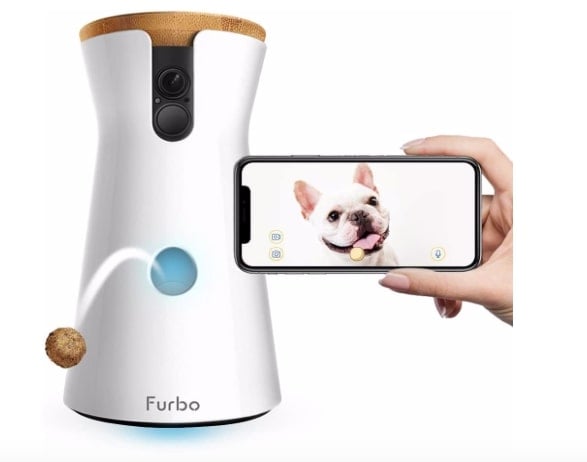- This review contains affiliate links. Read more here.
Getting a new puppy is exciting, but it also comes with a lot of changes to your routine. Your work schedule and social life have to flex around your puppy’s needs. Puppies crave company, exercise, and plenty of interaction. Plus, they can’t hold it for very long. So, how long can you leave a puppy alone, really? If you work full-time and have a puppy, you’re going to need help, especially in the first three months of a dog’s life. Consider hiring a loving pet sitter or in-home daycare provider for worry-free care.
Still, you don’t have to be with your puppy every second. Leaving them home alone for safe periods of time isn’t bad or dangerous; in fact, it’s important for them to adjust to some separation from you. Find out more about what you should consider when leaving a puppy home alone, and at what age it’s OK to do so.

Petcube
This WiFi camera allows you to keep an eye on your puppy from afar and even speak to him with two-way audio.
How Long Can Your Puppy “Hold It”?
Adult dogs generally need to pee between three to five times a day. But puppies need breaks much more often!
Generally, puppies can hold it for one hour per every month of age (so a three-month-old puppy can wait three hours to pee). Here are common time limits for puppies of different ages:
- 8–10 weeks: One hour or less. Puppies this young simply can’t hold their urine for more than an hour, and even that is pushing it, sometimes! You might start crate training at this age, but you can’t leave a young puppy in a crate for long periods; they’ll wet their bed (a lot!)
- 10–12 weeks: Bladder capacity is increasing, but two hours is still the longest that most puppies can hold it at this stage.
- 3–6 months: At this point, consider the one hour per month rule. Three-month-old puppies can wait for three hours, four-month-old puppies for four hours, and so on.
- After 6 months: An older puppy, like most adult dogs, has the ability to hold it for up to six hours. If you don’t have a dog door, be sure to pop home at lunch or get your pet sitter to pay a visit if you’re unable to do so.
Of course, the above estimates can vary depending on a puppy’s size, health, and habits. But any dog forced to hold their urine for too long is at risk for urinary tract infection, stones, or crystals. Plus, holding urine for too long is just plain uncomfortable, and can lead to accidents.
How Long Can You Leave a Puppy Alone in a Crate?
Wondering how to crate train a puppy, and how long you can leave your puppy alone in the crate? Professional dog trainer Shoshi Parks provides the full scoop on how to crate train a puppy, which you can read here.
To sum it up, crate training is important—but start out slow. Introduce your dog to the crate the first time with treats, and don’t close them in. Give them playtime in and near the crate. Then gradually build up to 10–15 minute intervals of crate time, sticking with these short periods of time until your doggie has adjusted.
When your puppy can tolerate the shorter amount of time, leave them alone in the crate for increasing periods of time. Eventually, your dog will become comfortable there.
You’ll want to be home while initially crate training; don’t leave a young dog alone in a crate for the whole workday. (This would also be a long time for an older dog!) Be sure to give your new family member lots of attention and love when they’re not confined.
Maximum daily time recommended in a crate, by age:
- 8–10 weeks: 30–60 minutes
- 11–14 weeks: 1–3 hours
- 15–16 weeks: 3–4 hours
- 17+ weeks: 4–5 hours (though please don’t resort to this often!)
As your dog gets older, they can be kept in the crate for longer periods of time. But keep in mind, it should always be used as a short-term solution. It’s important that your dog gets lots of exercise and human interaction.
Puppy-Proofing Your Home
Even if you’ll be home with your pup often, it’s important to get your home ready for those busy little paws and that curious nose (and mouth). Pet parents who thoroughly puppy-proof report fewer problems at home!
For the hours that you leave your puppy alone, consider a “puppy zone.” Choose a secure area of your home, whether it’s the entire living room, a bedroom, or a small portion of the kitchen sectioned off. Here’s what you’ll need:
How Long Can You Leave a Puppy Alone? The Best Toys and Chews
How long can you leave your puppy alone with a chew toy? Well, double-check the type. Avoid leaving puppies alone with rawhide, bully sticks, or any chews that could break apart, as pieces can get lodged in their throat. Safe puppy distractions include the following:
- Kong toys are a classic: fill them with treats or peanut butter. Freeze for a challenge!
- The big version of the treat-dispensing Bob-a-Lot is popular with our office dogs.
- Nina Ottosson puzzle toys are great for clever dogs.
- DIY enthusiasts can build their own puzzle toys.
- Safe chews are a must-have, like the Nylabone.
- Pet cameras are a fun splurge that lets you watch and communicate with your puppy from afar with a camera and two-way audio. Checkout the Petcube or treat-tossing Furbo.

Furbo
Two-way audio, night vision, and a treat tosser help keep you and your puppy connected when you’re away from home.
If you leave your puppy alone for too long, no matter how many toys they have, they can get separation anxiety. A puppy definitely needs companionship, playtime, and pee and poop breaks during the workday, so be sure to plan for that.
How Long Can You Leave a Puppy Alone? The Right Amount of Exercise is Key
Beyond potty breaks, your puppy needs lots of physical activity during the day. Exercise helps them:
- Stay healthy
- Digest meals
- Stimulate their mind
- Burn calories
- Avoid boredom (and boredom-induced destructive behaviors)
- Avoid separation anxiety
Individual exercise needs vary depending on your dog’s breed or breed mix. Herding and sporting dogs often need more intense activity; lower-energy breeds can do with less, according to this article by The Bark. But every puppy needs to burn off that energy, whether they’re a Border Collie or a Basset Hound, or a Labradoodle.
Before leaving your puppy alone for any period of time, make sure your puppy gets a brisk walk or play session of at least 20 minutes. Then, add a midday romp (with you or a dog walker) to help break up the day.
Beyond the exercise a dog needs each day, mental activity is important to keep puppies healthy, happy, and well-behaved when you leave them alone. Puppies and young dogs need more enrichment than adults. Without it, they may become bored, and even destructive, when left alone.
For maximum happiness for you and your pet, offer them enrichment opportunities when you’re home, and stuff to do when you’re out. Whether it’s a training session, exciting neighborhood walk, puzzle feeder, or a round of indoor games, enrichment activities help keep your dog healthy. They also balance out the time your dog spends alone.
Leaving a Puppy Alone: The Bottom Line
So, how long can you leave your puppy alone? In the first six months of life, puppies need a lot of attention, care, and exercise. Puppies younger than 10 weeks won’t be able to hold their urine for more than an hour at a time, and it’s not until six months of age that puppies can wait up to six hours to go to the bathroom.
Dogs are social animals. They will miss you when you’re gone and are prone to destructive behaviors or excess barking if they get lonely. Crate training helps, as does creating a “puppy zone,” and providing your puppy with lots of exercise, chew toys, and socialization.
A Rover dog sitter or in-home doggie daycare can give your puppy the activity they need during the day, and help you feel better about being gone.
How long can you leave a puppy alone? The question may actually be, how long can you stand to be away from your puppy? Enjoy that beautiful, special time with your new family member, and don’t feel guilty if you need to take a little extra time off to make it happen.
